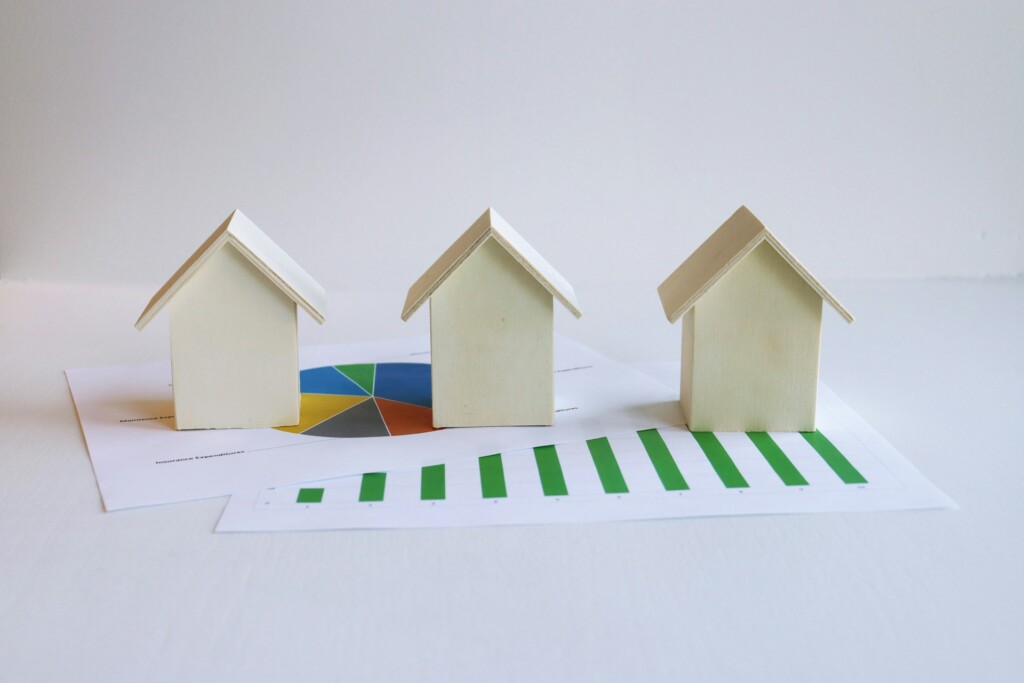Steel hit $912 per ton by February 2025, lumber tariffs continue pressuring supply chains, and skilled electricians now command nearly $30 per hour. These conditions directly shape what we see in today’s construction pricing landscape.
Building costs per square foot represent the total construction expense divided by the finished building area. Commercial offices range from approximately $289 to $437 per square foot for single-story structures, $330 to $870 for mid-rise buildings, and $430 to $1,001 for high-rise construction. Material volatility, rising labor rates, and tightening building codes create the foundation for these ranges, while residential construction typically averages $100 to $200 per square foot with premium markets exceeding $350.
Disclaimer: Pricing figures are based on publicly available market data and are intended for general estimation purposes as of October 2025. They do not represent a formal quote from EB3 Construction. Actual costs will vary by project scope, location, labor rates, and material prices.
How Do Building Type And Use Affect Building Costs Per Square Foot?

Building use directly shapes construction costs through specialized systems, structural complexity, and finish requirements. A simple warehouse requires basic steel framing and minimal MEP systems, while a hospital demands advanced HVAC for clean air, specialized electrical for medical equipment, and complex fire safety systems.
We see this pattern across every building category. Office buildings demonstrate this clearly with single-story structures averaging $289–$437 per square foot, while high-rise buildings jump to $430–$1,001 per square foot due to structural steel requirements, elevator systems, and enhanced fire safety infrastructure.
Commercial Office Buildings
Office construction costs scale with height and complexity. Single-story office buildings range from $289–$437 per square foot, requiring basic structural systems and standard MEP infrastructure. Mid-rise buildings increase to $330–$870 per square foot as elevator systems, enhanced structural support, and more sophisticated HVAC systems become necessary.
High-rise office buildings represent the upper tier at $430–$1,001 per square foot. These projects require steel or reinforced concrete frames, complex elevator systems, pressurized stairwells, and advanced building management systems that drive costs significantly higher than low-rise alternatives.
Industrial And Warehouse Facilities
Industrial buildings offer some of the most cost-effective construction options. Regional distribution centers average around $214 per square foot, utilizing pre-engineered metal buildings with basic electrical and minimal finish requirements. Light industrial warehouses cost approximately $238 per square foot, incorporating slightly more complex MEP systems for manufacturing processes.
The key advantage in warehouse construction lies in simple structural requirements, minimal interior finishes, and standardized building systems that we can replicate efficiently across projects.
Life Science And Laboratory Facilities
Laboratory construction represents one of the most expensive building categories, ranging from $600–$1,500 per square foot. Standard lab facilities typically cost around $635 per square foot, while high-end research spaces can exceed $1,200 per square foot. These facilities require specialized HVAC systems with precise temperature and humidity control, chemical-resistant materials, and advanced safety systems including fume hoods and emergency shower stations.
The complex MEP requirements in life science facilities often account for 40-50% of total construction costs, compared to 15-20% in standard office buildings.
Healthcare Facilities
Healthcare construction demands stringent compliance with medical codes and specialized systems. Medical office buildings range from $451–$1,018 per square foot, incorporating medical gas systems, specialized electrical for diagnostic equipment, and enhanced HVAC for infection control. Acute-care hospitals cost $450–$1,020 per square foot, requiring backup power systems, operating room infrastructure, and complex patient care technology.
Specialty clinics average $619 per square foot, falling between basic medical offices and full hospital complexity. These facilities need specialized equipment infrastructure while maintaining patient comfort and safety standards.
Educational Buildings
School construction varies significantly by educational level and facility type. Primary and secondary schools range from $300–$380 per square foot, incorporating basic classroom infrastructure, cafeteria facilities, and gymnasium spaces. University classroom buildings increase to approximately $580 per square foot due to larger lecture halls, enhanced technology systems, and more sophisticated HVAC requirements.
University laboratory buildings represent the highest educational construction costs at $756 per square foot, requiring specialized ventilation, chemical storage, and safety systems similar to commercial research facilities. Dormitories offer the most economical educational construction at $322 per square foot, utilizing repetitive room layouts and standard residential-grade systems.
Hospitality Buildings
Hotel construction costs correlate directly with service level and amenities. Three-star hotels average $478 per square foot, incorporating standard guest room finishes, basic amenities, and commercial-grade MEP systems. Five-star hotels jump to $691 per square foot, requiring luxury finishes, spa facilities, complex food service infrastructure, and enhanced guest services technology.
The significant cost difference reflects upgraded mechanical systems, premium materials, and specialized spaces like conference centers and recreational facilities that define luxury hospitality properties.
Retail Facilities
Retail construction spans a wide cost range based on size and tenant requirements. Neighborhood strip centers typically cost in the low $300s to high $300s per square foot, utilizing simple steel frame construction with basic storefront systems. Regional malls range from $461–$575 per square foot depending on regional factors, incorporating more complex structural systems, enhanced HVAC for large spaces, and sophisticated electrical infrastructure for diverse tenant needs.
The higher mall costs reflect common area requirements, complex fire safety systems, and infrastructure needed to support multiple retail tenants with varying utility demands.
Public And Community Facilities
Public buildings often require the highest construction costs due to durability requirements and specialized functions. Museums and performing arts centers range from $650–$1,272 per square foot, incorporating specialized acoustic systems, climate control for artifacts, and complex lighting infrastructure. Government administrative buildings cost $426–$844 per square foot, requiring enhanced security systems, durable materials, and accessibility compliance.
Recreation centers and gymnasiums range from $347–$683 per square foot, while police stations average $580 per square foot. These facilities need specialized equipment infrastructure, enhanced security systems, and durable construction materials designed for heavy public use.
Parking Structures
Parking represents the most economical construction category. Above-ground parking structures cost approximately $71 per square foot, utilizing simple concrete or steel frame construction with minimal MEP systems. Underground and multi-level parking increases to $143 per square foot due to excavation costs, enhanced structural requirements, and more complex ventilation systems needed for enclosed spaces.
[[artifact_table]] Commercial building costs per square foot by building type and complexity [[/artifact_table]]
The cost variations between building types reflect the fundamental relationship between function and construction complexity. Simple storage functions require minimal systems and finishes, while specialized uses like healthcare and laboratories demand sophisticated infrastructure that doubles or triples basic construction costs.
How Much Do Building Costs Per Square Foot Vary by U.S. Region?
Regional markets impose substantial cost variations across the United States, with differences of up to 70% between markets. Labor availability, material transportation costs, and local building codes create distinct pricing patterns that we encounter regularly in our multi-market projects.
Eastern U.S. Construction Costs
The Eastern region represents the highest-cost construction environment, driven primarily by dense urban markets and stringent regulatory requirements. Single-story office buildings range from $301 to $361 per square foot, while mid-rise structures command $599 to $719 per square foot. High-rise construction reaches $688 to $827 per square foot due to complex structural requirements and elevated safety standards.
Strip centers cost between $309 and $371 per square foot, with regional malls ranging from $461 to $554 per square foot. Hotel construction varies significantly by service level, with three-star properties averaging $489 to $604 per square foot and five-star facilities reaching $677 to $871 per square foot. Educational facilities typically fall between $317 and $381 per square foot.
Western U.S. Construction Costs
Western markets balance high labor costs with varied regulatory environments, creating unique cost structures we navigate across different states. Single-story offices cost $313 to $378 per square foot, while mid-rise buildings range from $481 to $607 per square foot. High-rise construction averages $557 to $730 per square foot, reflecting seismic code requirements and specialized engineering needs.
Strip centers show wider variation at $261 to $430 per square foot, while regional malls range from $400 to $575 per square foot. Hotel costs span $402 to $545 per square foot for three-star properties and $577 to $849 per square foot for luxury facilities. School construction typically costs $341 to $417 per square foot. California averages $250 to $350 per square foot across many commercial projects, though urban coastal markets command premium pricing.
Midwest U.S. Construction Costs
The Midwest offers the most cost-effective construction environment, with seasonal considerations affecting scheduling but providing competitive pricing. Single-story offices range from $237 to $298 per square foot, with mid-rise buildings costing $454 to $556 per square foot. High-rise construction spans $554 to $689 per square foot.
Strip centers cost between $284 and $340 per square foot, while regional malls range from $423 to $507 per square foot. Hotel construction varies from $400 to $533 per square foot for three-star properties and $537 to $762 per square foot for luxury establishments. Educational facilities typically cost $242 to $292 per square foot. Basic office fit-outs can be accomplished for $120 to $180 per square foot, with industrial construction often ranging $100 to $150 per square foot.
Southern U.S. Construction Costs
Southern markets provide moderate construction costs with extended building seasons that improve project efficiency. Single-story office construction ranges from $238 to $286 per square foot, while mid-rise buildings cost $474 to $569 per square foot. High-rise construction typically spans $545 to $654 per square foot.
Strip centers range from $245 to $294 per square foot, with regional malls costing $366 to $439 per square foot. Hotel construction varies from $341 to $478 per square foot for three-star properties and $462 to $683 per square foot for five-star facilities. Educational construction averages $217 to $260 per square foot. Basic commercial builds often range from $100 to $200 per square foot, providing cost-effective options for standard construction.
Urban Market Premiums
Dense metropolitan areas impose additional cost pressures through urban logistics challenges and specialized code requirements. New York City construction often ranges from $350 to $500+ per square foot for many commercial projects, reflecting complex permitting processes and elevated labor markets. Coastal markets typically command premium pricing due to specialized requirements for seismic codes, environmental regulations, and constrained labor supply.
Climate impacts also influence regional pricing, with cold-weather markets facing seasonal construction limitations and specialized foundation requirements. Conversely, hot-climate markets deal with summer work restrictions and specialized HVAC demands that affect project costs and scheduling.
What Factors Drive Increases Or Savings In Cost Per Square Foot?

Construction material volatility stands at the center of cost fluctuations we track across projects. Steel prices experienced dramatic swings from approximately $425 per ton in mid-2020 to peaks exceeding $950 per ton by March 2022, currently settling around $912 per ton. Lumber pricing faces continued pressure from Canadian import tariffs, while concrete and asphalt costs track directly with fuel price variations that affect transportation and raw material production.
Construction labor costs reflect broader workforce challenges impacting project budgets. Median hourly wages across construction trades now hover between $21 and $30, with specialized positions commanding premium rates. Skilled electricians earn approximately $29.61 per hour according to recent Bureau of Labor Statistics data, while plumbers and pipefitters see similar compensation at around $29.59 per hour. We observe how an aging workforce creates supply constraints, pushing wage competition higher as experienced workers retire faster than new talent enters the field.
Design complexity and finish specifications directly influence per-square-foot costs through system requirements and material selections. High-end interior finishes and complex structural systems add substantial expense to base construction costs. MEP systems typically account for about 13% of total project budgets, with HVAC systems representing approximately 4.4%, plumbing at 4.3%, and electrical work consuming roughly 4.2% of costs. Foundation work generally comprises 10-11% of project expenses, varying with soil conditions and structural requirements.
Building codes and compliance standards continue expanding project scope and associated costs. Stricter International Building Code requirements, LEED certification processes, and specialized seismic or coastal regulations add layers of complexity and expense to construction projects. These compliance measures often require additional engineering analysis, specialized materials, and enhanced construction techniques that drive up per-square-foot pricing.
Market conditions create external pressure on construction pricing through inflation and financing costs. Current inflation rates hover near 3% year-over-year, while construction financing rates remain between 4.25% and 4.50%. Supply chain disruptions persist, affecting material availability and pricing predictability throughout project timelines.
Technology adoption offers significant opportunities for cost control and project efficiency. Modular construction techniques can reduce project timelines by up to 50% while cutting total costs by approximately 20% through factory-controlled production and reduced site labor requirements. Building Information Modeling helps minimize design errors and construction rework, preventing costly change orders during construction phases.
We recommend several practical steps for cost management across projects. Conduct comprehensive site assessments early in the planning process to identify potential complications before they impact budgets. Utilize construction cost estimation software to maintain accurate pricing throughout design development. Collaborate closely with design teams and cost estimators to validate assumptions and optimize building systems. Plan contingency budgets between 10-20% of total project costs to accommodate market fluctuations and unforeseen conditions.
How Should You Estimate Building Costs Per Square Foot For A Project?
We approach construction estimating with a systematic workflow that delivers defensible numbers. This process ensures developers and property owners can make informed budget decisions while accounting for the complexity inherent in construction projects.
Define Project Scope And Building Classification
Start by clearly defining the project scope, building class (A, B, or C), and gross square footage. Building class determines finish level expectations and MEP system complexity. Class A buildings require premium materials and sophisticated systems, while Class C projects use standard specifications throughout.
Document the exact square footage using gross building area measurements. This becomes your base multiplier for all subsequent calculations. We verify these measurements against architectural drawings and reconcile any discrepancies before proceeding.
Select Appropriate Building-Type Cost Ranges
Match your project to established cost ranges based on building use and structural requirements. Office buildings vary dramatically, from single-story structures at $289-$437 per square foot to complex high-rise projects reaching $430-$1,001 per square foot. Healthcare facilities command higher ranges due to specialized infrastructure requirements.
Multiply the selected cost range by your total square footage to establish a base construction cost estimate. This calculation provides the foundation for all subsequent adjustments and refinements.
Apply Regional And Code Adjustments
Regional market conditions and local building codes significantly impact final costs. Western markets often see ranges of $313-$378 per square foot for single-story office construction, while similar projects in the Midwest typically fall between $237-$298 per square foot.
Factor in zip code-specific conditions including labor availability, material transportation costs, and permit requirements. Seismic codes in California add structural reinforcement costs, while coastal markets face elevated material delivery expenses.
Calculate Soft Costs And System Allowances
Soft costs represent a substantial portion of total project expenses. Design fees typically range from 2.5% to 12% of construction costs, depending on project complexity and architect selection. Permits generally add 0.5% to 3%, while insurance requirements contribute 1% to 5% to the overall budget.
Project management fees commonly fall between 5% and 10% of hard costs. Landscaping expenses vary widely, from $4 to $20 per square foot depending on site conditions and aesthetic requirements. Sustainability compliance, when applicable, adds 5% to 15% for LEED certification and green building features.
Build In Appropriate Contingency Reserves
Contingency budgeting protects against scope changes and market volatility. We recommend carrying 10% to 20% contingency based on project complexity and market conditions. Simple warehouse projects warrant lower contingencies, while complex healthcare facilities require higher reserves.
Document the contingency calculation methodology and approval process. This ensures stakeholders understand how contingency funds will be managed throughout construction phases.
Leverage Technology And Validation Methods
Digital estimating tools improve accuracy and reduce calculation errors. These platforms integrate current material pricing and labor rates, providing real-time cost adjustments. We complete comprehensive site assessments to identify conditions that could impact construction costs or sequencing.
Obtain multiple qualified bids from reputable contractors to validate estimates. This competitive process reveals market pricing and identifies potential cost discrepancies. Compare contractor proposals against internal estimates to ensure alignment with current market conditions.
Practical Application Example
Consider a 10,000 square foot single-story office building in the San Francisco Bay Area with mid-level finishes. Using the Western regional range of $313 to $378 per square foot, the midpoint calculation yields $345 per square foot. Multiplying by 10,000 square feet produces a base construction cost of approximately $3.45 million.
Add soft costs for design fees, permits, and project management, then apply a 15% contingency for market conditions and scope adjustments. This systematic approach delivers a comprehensive budget that accounts for all major cost components and risk factors.
Conclusion: Key Takeaways And Next Steps

Building costs per square foot in 2025 reflect the complexity of modern construction. We see significant variance across building types, with office buildings ranging from $289 per square foot for single-story structures to over $1,000 per square foot for high-rise complexes. Healthcare facilities, laboratories, and cultural buildings command premium pricing due to specialized systems and stringent regulatory requirements, while parking structures remain among the most cost-effective builds at $71 to $143 per square foot.
Regional cost spreads underscore the importance of location-specific planning. Coastal urban markets like New York City and San Francisco consistently drive costs above $350 per square foot, while Midwest and Southern regions offer more moderate pricing. These differences stem from labor market conditions, material logistics, and varying code requirements that we must factor into every project estimate.
We control construction risk through early planning and systematic validation of project assumptions. Conducting thorough site assessments, validating zip-code specific pricing, and leveraging BIM technology help minimize errors and rework. Modular construction offers substantial time and cost savings where applicable, reducing total project costs by approximately 20%. Every project should carry a 10 to 20 percent contingency to accommodate market volatility and scope adjustments. Aligning estimates with building type ranges, incorporating regional factors, and accounting for soft costs creates realistic budgets that support successful project delivery. Partner with EB3 Construction to develop accurate cost estimates tailored to your specific project requirements.




